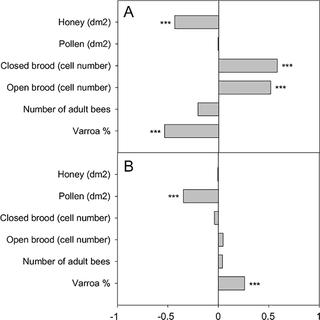PLOS ONE ( IF 2.9 ) Pub Date : 2018-12-13 , DOI: 10.1371/journal.pone.0209192 Cedric Alaux , Samuel Soubeyrand , Alberto Prado , Mathilde Peruzzi , Alban Maisonnasse , Julien Vallon , Julie Hernandez , Pascal Jourdan , Yves Le Conte

|
Honeybee colonies are increasingly exposed to environmental stress factors, which can lead to their decline or failure. However, there are major gaps in stressor risk assessment due to the difficulty of assessing the honeybee colony state and detecting abnormal events. Since stress factors usually induce a demographic disturbance in the colony (e.g. loss of foragers, early transition from nurse to forager state), we suggest that disturbances could be revealed indirectly by measuring the age- and task-related physiological state of bees, which can be referred to as biological age (an indicator of the changes in physiological state that occur throughout an individual lifespan). We therefore estimated the biological age of bees from the relationship between age and biomarkers of task specialization (vitellogenin and the adipokinetic hormone receptor). This relationship was determined from a calibrated sample set of known-age bees and mathematically modelled for biological age prediction. Then, we determined throughout the foraging season the evolution of the biological age of bees from colonies with low (conventional apiary) or high Varroa destructor infestation rates (organic apiary). We found that the biological age of bees from the conventional apiary progressively decreased from the spring (17 days) to the fall (6 days). However, in colonies from the organic apiary, the population aged from spring (13 days) to summer (18.5 days) and then rejuvenated in the fall (13 days) after Varroa treatment. Biological age was positively correlated with the amount of brood (open and closed cells) in the apiary with low Varroa pressure, and negatively correlated with Varroa infestation level in the apiary with high Varroa pressure. Altogether, these results show that the estimation of biological age is a useful and effective method for assessing colony demographic state and likely detrimental effects of stress factors.
中文翻译:

测量生物学年龄以评估蜜蜂的殖民地人口统计资料
蜜蜂殖民地越来越多地受到环境压力因素的影响,这可能导致它们的衰败或失败。但是,由于难以评估蜜蜂的菌落状态和检测异常事件,因此在应激源风险评估中存在重大差距。由于压力因素通常会导致群体中的人口统计学扰动(例如,觅食者的流失,从护士到觅食者的早期过渡),我们建议可以通过测量与年龄和任务相关的蜜蜂的生理状态来间接揭示这些扰动。被称为生物年龄(在整个生命周期中发生的生理状态变化的指标)。因此,我们根据年龄和任务专门化的生物标记物(玻璃素黄素和脂肪代谢激素受体)之间的关系估算了蜜蜂的生物学年龄。该关系是从一组已知年龄的蜜蜂的校准样本中确定的,并对其进行数学建模以预测生物学年龄。然后,我们确定了整个觅食季节中低(常规养蜂场)或高(高养蜂场)蜂群生物学年龄的演变Varroa破坏物侵染率(有机养蜂场)。我们发现,蜜蜂从春季的生物学年龄从春季(17天)到秋季(6天)逐渐降低。但是,在有机养蜂场的殖民地中,从春季(13天)到夏季(18.5天)人口老龄化,然后在Varroa处理后的秋天(13天)复原。生物学年龄呈正育雏的(开孔和闭孔)中具有低的蜂房量相关瓦压力和负相关瓦在具有高的蜂房侵染水平瓦压力。总而言之,这些结果表明,对生物年龄的估计是一种有用且有效的方法,用于评估菌落的人口统计状况以及压力因素的可能有害作用。











































 京公网安备 11010802027423号
京公网安备 11010802027423号